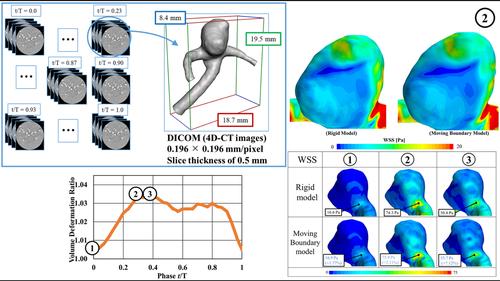当前位置:
X-MOL 学术
›
Int. J. Numer. Method. Biomed. Eng.
›
论文详情
Our official English website, www.x-mol.net, welcomes your feedback! (Note: you will need to create a separate account there.)
Numerical simulation of flow behavior in basilar bifurcation computed tomography angiography
International Journal for Numerical Methods in Biomedical Engineering ( IF 2.1 ) Pub Date : 2024-01-31 , DOI: 10.1002/cnm.3805 Ryo Shimodoumae 1 , Gaku Tanaka 1 , Ryuhei Yamaguchi 2 , Makoto Ohta 2
International Journal for Numerical Methods in Biomedical Engineering ( IF 2.1 ) Pub Date : 2024-01-31 , DOI: 10.1002/cnm.3805 Ryo Shimodoumae 1 , Gaku Tanaka 1 , Ryuhei Yamaguchi 2 , Makoto Ohta 2
Affiliation

|
In this study, a moving boundary deformation model based on four-dimensional computed tomography angiography (4D-CTA) with high temporal resolution is constructed, and blood flow dynamics of cerebral aneurysms are investigated by numerical simulation. A realistic moving boundary deformation model of a cerebral aneurysm was constructed based on 4D-CTA in each phase. Four hemodynamic factors (wall shear stress [WSS], wall shear stress divergence [WSSD], oscillatory shear index [OSI], and residual residence time [RRT]) were obtained from numerical simulations, and these factors were evaluated in basilar artery aneurysms. Comparison of the rigid body condition and the moving boundary condition investigating the relationship between wall displacement and hemodynamic factors clarified that the spatial-averaged WSS and maximum WSSD considering only the aneurysmal dome has a large difference between conditions during the peak systole, and there were also significant differences in OSI and RRT.
中文翻译:

基底动脉分叉CT血管造影血流行为的数值模拟
本研究构建了基于高时间分辨率四维计算机断层扫描血管造影(4D-CTA)的移动边界变形模型,并通过数值模拟研究了脑动脉瘤的血流动力学。基于4D-CTA各时相构建逼真的脑动脉瘤移动边界变形模型。通过数值模拟获得了四个血流动力学因素(壁剪切应力[WSS]、壁剪切应力散度[WSSD]、振荡剪切指数[OSI]和残余停留时间[RRT]),并在基底动脉瘤中评估这些因素。通过比较刚体条件和移动边界条件来研究壁位移与血流动力学因素之间的关系,结果表明,仅考虑动脉瘤穹顶的空间平均 WSS 和最大 WSSD 在收缩高峰期间的条件之间存在较大差异,并且还存在OSI 和 RRT 之间存在显着差异。
更新日期:2024-01-31
中文翻译:

基底动脉分叉CT血管造影血流行为的数值模拟
本研究构建了基于高时间分辨率四维计算机断层扫描血管造影(4D-CTA)的移动边界变形模型,并通过数值模拟研究了脑动脉瘤的血流动力学。基于4D-CTA各时相构建逼真的脑动脉瘤移动边界变形模型。通过数值模拟获得了四个血流动力学因素(壁剪切应力[WSS]、壁剪切应力散度[WSSD]、振荡剪切指数[OSI]和残余停留时间[RRT]),并在基底动脉瘤中评估这些因素。通过比较刚体条件和移动边界条件来研究壁位移与血流动力学因素之间的关系,结果表明,仅考虑动脉瘤穹顶的空间平均 WSS 和最大 WSSD 在收缩高峰期间的条件之间存在较大差异,并且还存在OSI 和 RRT 之间存在显着差异。



























 京公网安备 11010802027423号
京公网安备 11010802027423号